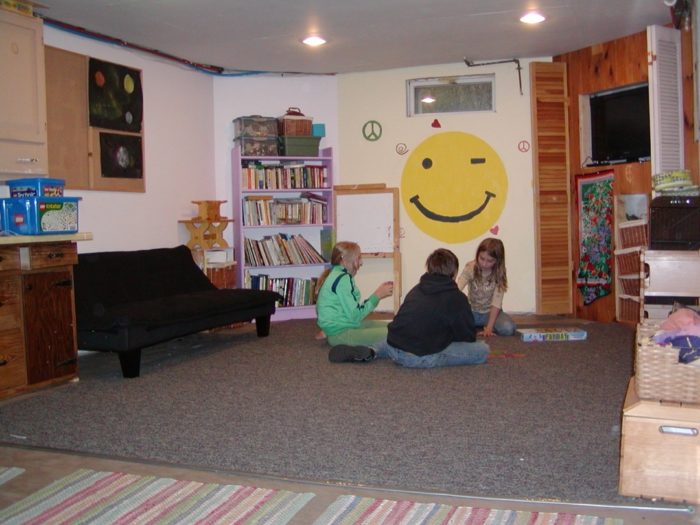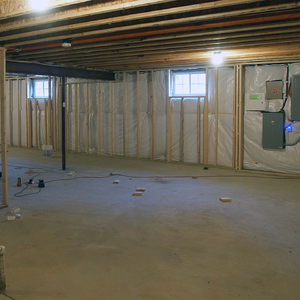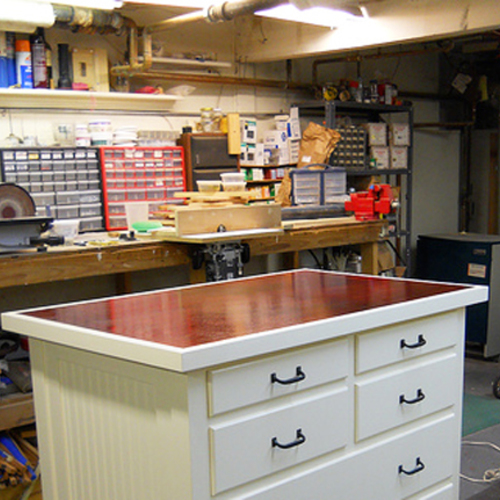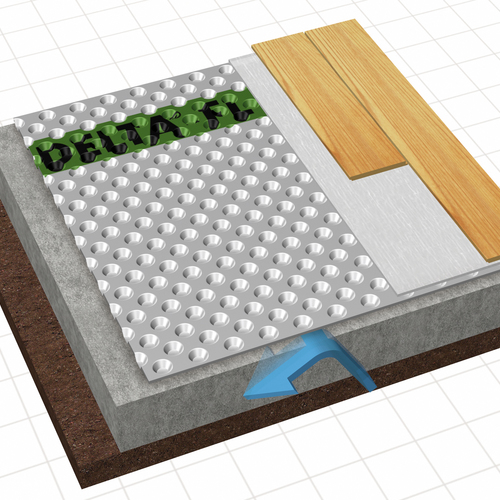
Image Credit: Peter Yost
Designing dry, warm basement floors
Dry, warm, basement floors are designed to manage:
- Water at ground level — gutters and downspouts connected to splash blocks on soil sloped away from the building;
- Water at the footing — perimeter pipe drainage at the footing;
- Water in porous materials — a capillary break (for example, free-draining gravel or a nonporous sheet good like polyethylene) underneath the slab, between the concrete walls and the soil, and between the footing and the foundation walls.
- Floor surface temperature — subslab rigid insulation warms the basement slab and elevates its temperature.
So, you have designed your dry basement like this, or you have renovated it like this.
The basement floor is dry, you think
Before you put any finished flooring down on what appears to be a dry floor, it’s a smart thing to determine just how dry it really is. Many basement concrete floors don’t have a capillary break or vapor barrier installed underneath them and evaporate what can be quite a bit of water off of their surface, water that is wicking from the soil up through the concrete.
There are two simple tests to determine slab moisture transmission (see “Concrete in Practice 28 – Concrete Slab Moisture”). One involves just taping down a sheet of plastic for at least 16 hours and seeing if the underside of the plastic is wet (ASTM D4263). If it’s dry, congratulations – you can put down any finished flooring product you want to. If it’s wet, you might want to consider the next test, the anhydrous calcium chloride test (ASTM F1869), which can tell you the RATE of moisture transmission. Knowing this rate means that you can check flooring manufacturer recommendations on moisture transmission rates and see what types of flooring can handle what your slab is doing.
Keep in mind that many types of flooring go down with water-soluble adhesives; that can be a real problem if your slab is drying a lot of water through its surface.
Carpet in basements
Many, but certainly not all, carpets and carpet cushion are vapor-permeable, so if your basement slab is transmitting moisture, it can continue to evaporate up through the pad and carpet. On the other hand, if the carpet or pad is on a cool slab and it is loaded with dirt, pet and human dander, it’s just about a perfect place to cultivate dust mites and even mildew.
The bottom line?
If your basement slab is un-insulated and/or damp or transmitting moisture (and most are):
- Avoid installed wall-to-wall carpeting. Choose a hard surface material that meets manufacturer recommendations for what you know to be how much moisture is transmitting up through your basement slab.
- Maintain gaps for air circulation. Keep absorbent materials up off the basement floor and keep gaps between your slab and all objects, such as furniture.
- Keep your basement floor clean. Damp mop or vacuum your basement floor on a regular basis, based on use and traffic. If you’re using area rugs, launder or clean these on a regular basis and ideally, give them regular exposure to direct sunlight by taking them outside.
- Manage relative humidity in the basement. Use an Energy Star-labeled dehumidifier to keep the interior relative humidity at or below 60%.
Weekly Newsletter
Get building science and energy efficiency advice, plus special offers, in your inbox.














17 Comments
basement flooring
I would agree with all that was said. So why would the GC guidelines not allow builders to use some of these options to determine if we can use carpet in the construction process. Adoption of good building practices will only be used if they conform to the way in which people live. Mandating a product will not work for most people. At some point there is a tradeoff between good building practice and lifestyle. If they move in and add a less inferior carpet or the wrong type they end up in a worse position.
carpet in basements
I don't know the research well enough to quote % reductions, but i would start by having the homeowner install an active sub-slab radon mitigation system. While it helps remove radon from below the slab - a serious issue in MN - it will also help remove moisture from below the slab - helping to keep the basement dry. Polished concrete is a great solution to making an old slab look contemporary and it is price competitive to low-cost carpet. Area rugs - applied as Peter has mentioned - will provide softness and warmth.
Carpet on basement floors
This is analogous to Willy Wonka where he in straight face advises: "don't do that."
Just as a spoiled child wants a wonka candy we want carpet or wood floor.
Face it basements were never intended to be true living space.
Simply put in our climate -Minnesota- with the colder deep soil temperatures we need to also be concerned with summer time humidity rising in basements to the point of supporting mold growth.
Carpet serves as a bank for organic matter. Cleaning, vacuuming , just does not remove it all.
The mold spores are in the air. Simple math: Organic matter+mold spores+ temperature+ humidity=mold growth.
Use a floor system that can be sanitized like tile. An Area rug if you must. Carpet will never work in the long haul.
carpet in basements
Yes, basements were not intended as living space but that is how they are and will continue to be used. Sub-slab mitigation is a great solution if cost wasn't a barrier in pre-existing rehab projects but we are talking about federally subsidized lower income home ownership here.
Setting aside the ideal, as a safe and affordable housing industry, what can we do with the reality that we have? Do waterproof coatings work as a pretreatment before carpeting? Do the same issues/concerns prevail with slab on grade buildings? Do we need to encourage the development of new products?
Carpet in the basement is
Carpet in the basement is like drilling holes in your roof. Will the attic stay dry? Absolutely, as long as it doesn't rain! I like the "simple math" comment. Basements in MN can never be treated the same as upper floors. Peter's comments are right on.
Carpets in basements
This seems like another opportunity to create an "issue" but no reasonable solution. To tell Minnesota homeowners that addiing to their living space by carpeting a basement, something that we have been doing without problems for several years is suddenly no longer acceptable.
I agree that doing a moisture test is a great way to find out what if any problems there are.
In addition to that, if there is moisture, that simply sealing the concrete before installation seems to me to be a "solution".
In addition, putting in ceramic tile is not always a solution for everyone as it is one of the most expensive floors to have installed. Then to invest in a rug so they can use the space is additional costs many can not afford. Don't forget you may have to purchase infloor heat if you truly want to be able to enjoy this space with the cold floors.
I remember years ago I heard how doctors were telling people to pull all of their carpet out and put in all hard surfaces to if they had allergies.
Then when the Lung Association built thier house, they did a study and found that dust and pollen was constantly floating through the air when there was no carpet to obsorb it causing more problems.
They also recommended the use of PTE carpets which are made up of recycled plastic. Every situation is different.
Most homes built in the past 10 years have a vapor barrier between the ground and the concrete. I strongly disagree that carpet is never an option.
There are several issues at
There are several issues at play here and Peter did a great job of setting up the problem. If we build the slab properly (both warm and dry), carpet might be an option. But typical slabs are usually cold and wet. So they end up a "roll of the dice". -- some might work under certain conditions and others won't.
Keep in mind that there two separate water issues at work in this application. The first is capillary water and vapor movement from below the slab towards the house. The second is condensation on the slab surface from indoor humidity. For example, a sealer helps with the first, but makes the second problem worse, because it removes temporary absorption and storage by the concrete. An ASD system has been shown to reduce the indoor humidity in the basement in the winter, spring, and fall, but not in the summer. So it could help with the second concern, but not when you really need it during hot, humid summer periods with cool ground temperatures. And as for the first concern, it doesn't necessarily dry the soil out, unless you send a lot of heated house through it on the way to the suction point. That's probably not a very efficient approach since it means a bigger fan and lots of air and energy from the house.
The bottom line from a physics perspective is pretty simple: 1) it takes energy to manage moisture and 2) warmer is dryer and cooler is wetter. When you drop the carpet on the slab, house energy is removed and the slab and the slab-carpet interface is much cooler. This means less energy to dry water from below and a cooler surface for condensation from above.
The bottom line from a pragmatic standpoint is pretty easy as well. While it is possible to put carpet on some basement slabs, it comes at a greater cost and requires active homeowner management (cleaning, humidity control, etc.). Unless folks are willing to put a lot more energy and money into this practice (carpet on the slab) the simple answer is "just say no"!
are there other options?
carpet tiles is a workable idea. polished concrete, but what's a typical cost to do it?
are there floor paints that might work?
expoy/resin floors?
floating floors?
One of the challenges we face in Minnesota is that a lot of housing from a certain period is built as a "split level," where the lower floor is halfyway buried. These spaces were intended to be used as bedrooms and family rooms, and there's a marketability issue if they do not have carpet. What other options are safe?
carpet in basements
Great explanation of the physics of the problem, thank you. "Just say no" works great for the developer who builds and then moves on. What about the new homeowner who wants to utilize this space after they move in? After all, most other homes have finished basements with carpet in them for warmth.
I acknowledge Chris' comment who recognized that new, lower income homeowners will in all likelihood install the least expensive product to meet their immediate goal. That product will also most likely be the worst for indoor air quality.
Which can we most affect, physics or human nature? We can build "Green Communities" but how do we learn to live in them?
Be careful of floating floors
A floating floor has the same issues as carpet, but probably worse. It retards heat flow and vapor flow. That space will certainly be cold, wet, and moldy. So it must be totally isolated from the house. Or you can actively pressure manage that cavity with dry air ventilation to limit mositure accumulation and/or contamination of the house air.
Years ago, the Scandanavians (primarily Swedes) used floating floors on slabs in residences and schools and had horrendous results. I think the have limited their use, but haven't verified that.
This isn't saying it will always happen. It is saying that for most existing basements it is pretty risky. Clearly there are are ways to do this and reduce that risk -- but it might cost extra energy, time, or money.
Also keep in mind that any water event (plumbing leaks, sink or washing machine overflow, toilet disaster, water intrusion, rain in an open window, etc.) can easy get to the basement and will add considerable complexity for both carpet and floating/sleeper floors. I think future recoverability and cleanability is a big consideration. For most homes this isn't an if, it is a when!
what CAN folks do?
Pat - Your message of risk comes through loud and clear, and your reasoning makes perfect sense. How can builders respect the risk and rehab homes in a way the market will accept?
Again, I'm thinking of those split-level homes. What other options do those builders have (that minimize the risks)? Not occupying the lower level of split-level homes isn't viable in the market.
Amy - I can you respond to Chris' question in the very first comment about the Green Communities criteria? The blog seems to suggest options that don't totally square with the Criteria.
Does this blog square with Green Communities Criteria?
I am going to try and address at least one of the issues inherent to this question, since Amy is not able to respond until early next week.
Here is the language in the Green Communities Criteria 2008, page 8, Criterion 7.4:
"Do not install carpets in below grade living spaces, entryways, laundry rooms, bathrooms, kitchens
or utility rooms."
My understanding is that this language is based on the National Center for Healthy Housing (NCHH) Fact Sheet 2008, "Carpets and Healthy Homes" (www.nchh.org/Portals/0/Contents/CarpetsHealthyHomes.pdf). And it states:
"Avoid wall-to-wall carpets in damp areas and in rooms of individuals with allergies or asthma. Avoid installing wall-to-wall carpeting in bathrooms, kitchens, laundry rooms, basements, or other damp areas."
The key is that area rugs, while admittedly not the best-suited finish material for a basement floor that is cold and/or transmitting moisture, are quite different than installed wall-to-wall carpeting. Installed wall-to-wall carpeting:
1. cannot be removed for cleaning and exposure to intense solar radiation,
2. is much more likely to trap moisture when large surfaces in contact with the flooring prevent moisture transmission,
3. cannot easily be removed when a wetting event has or is likely to occur, and
4. cannot be readily inspected for moisture problems taking place underneath the flooring.
Hope this helps - Peter
Other options?
Janne -
Please take a look at the two information resources with links in the blog. They include a discussion of just what other approaches or options are available.
Older split-level and slab-on-grade homes (ones without the proper foundation drainage, capillary breaks and vapor barriers) are really challenging because, as you say, the concrete slab is the structural floor not for auxiliary space such as basements, but dedicated living spaces. Sometimes you get lucky and the floors tolerate carpet, but quite often they don't and the fix is either quite expensive or involves an approach similar to my basement: a finished coat of Masco Silpro (http://www.silpro.com/products.shtml) and a concrete stain with an area rug.
response to Janne and Chris
I am so happy to see all of these great responses…we picked a great topic!
Chris, you are right, the Enterprise Green Communities Criteria doesn’t allow for carpet in basements per mandatory criterion 7.4, Green Label Certified Flooring. We also we encourage the use of durable, hard surfaces in other places of the house through the optional criterion 7.16, Healthy Flooring Materials: Alternative Sources. The details of these two criteria were based on research and recommendations provided to us by the National Center for Healthy Housing. Here is a fact sheet that NCHH prepared on the topic of carpet: http://www.nchh.org/Portals/0/Contents/CarpetsHealthyHomes.pdf.
My understanding of the building science behind criterion 7.4 is that basements are just more humid than other parts of the house – whether a vapor barrier was laid or not. Basically, the slab is cooler than the air around it. Because of that, moisture will likely condense on the slab, under the carpet and pad and will lead to the growth of mildew.
Build it right
From the discussion so far it would appear that the one blanket rule to cover all construction might not be in order. Although ALL risk is not taken away, there is no way to reduce all mold risk inside a home, whether the space in question is below grade or elevated off the ground. There are steps that can be taken in new construction (some that are by code) that will make on slab concrete and below grade concrete less friendly to mold.
We build with a permanent wood foundation(pwf). An option with the permanent wood foundation is a wood floor below grade. All of this discussion so far has been about placing wall-to-wall carpeting on concrete. I have not built a home with a wood floor in the basement but there are builders in Minnesota that have. PWFs by design are well drained foundations that have an active system for removing the ground water around and under the home.
Many sections of the code break out methods and practices based on climate conditions. So my question is doesn't which climate condition the structure is in make a difference? Even Minnesota with their energy code recognize that Minnesota is in atlest two different climates (enviroments).
Also in any tight construction, as specified in the other sections of the Criteria, the homes need an active system for helping remove the moisture in the air, or moisture laden air. Without an active system the homes build to the tightness required, the basement floor will not be the problem area. The problems will show up much more in the winter than the summer though.
As for not being able to dry stretched wall to wall carpeting, I disagree. a corner can easily be pulled up and a fan placed under the edge to dry out the pad and the carpet from underneath. The adhered floorings are the ones that are impossible to to dry underneath. There are a few adhered products that make more sense in a wet area (tile, linolium as examples).
As for teh building science statement, i am open to doing testing to prove out whether there really is more mold growth in carpeting installed on concrete than on wood, but if you run down the entire science reasoning, the air is not in contact with the slab as the carpeting and pad would have a blanket effect. Yes some of that moisture from the air will migrate down, but it might not be in high enough concentrations to make it a mold environment.
Split entry & split level
I think Peter did a great job summarizing the more conventional options for the split entry, split level, and daylight basement option in the original article and his follow-up posts. The theoretical solution needs to be a poor insulator (to minimize the thermal gradient and provide heat for drying), have a low thermal storage capacity and some resilience (to provide thermal and physical comfort), and have high permeabilty (for drying). It is easy to meet two of these carpet, tile, etc., but very difficult to get all three. I think there might be some more exotic solutions, but they will undoubtedly be expensive to purchase and/or to operate and will likely require active occupant engagement and monitoring. Both of these are a challenge for this program and its end users. A high perm, low r-value area rug is looking pretty good.
Keep in mind this is much bigger than "carpet on basement floors". We still don't have all the answers on carpet for above grade floors. And how about slab-on-grade floors. They aren't that much different than a shallow basement floor.
Below Grade installations and Warranty of Products
I like to add the economic issues of products to the forums because we deal with that issue. ALWAYS check the manufacturer's warranty for below grade installs. Most products, including floating floors and carpet, are not covered in any type of below grade application. Unfortunately, I have to read the fine print of all the products that we sell and you would be shocked what actions void any type of warranty, etc. The latest includes the use of adhesives. If the installer does not use the manufacturer's adhesive in any application, the warranty is void. We no longer sell that line of products.
Log in or create an account to post a comment.
Sign up Log in